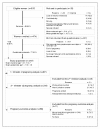Epidemiology of nausea and vomiting of pregnancy: prevalence, severity, determinants, and the importance of race/ethnicity
- PMID: 19573237
- PMCID: PMC2713199
- DOI: 10.1186/1471-2393-9-26
Epidemiology of nausea and vomiting of pregnancy: prevalence, severity, determinants, and the importance of race/ethnicity
Abstract
Background: Studies that contributed to the epidemiology of nausea and vomiting of pregnancy have reported conflicting findings, and often failed to account for all possible co-variables necessary to evaluate the multidimensional associations. The objectives of this study were to: 1) Estimate the prevalence and the severity of nausea and vomiting of pregnancy during the 1st and the 2nd trimester of pregnancy, and 2) Identify determinants of presence and severity of nausea and vomiting of pregnancy during the 1st and 2nd trimesters separately, with a special emphasis on the impact of race/ethnicity.
Methods: A prospective study including pregnant women attending the Centre Hospitalier Universitaire (CHU) Sainte-Justine or René-Laennec clinics for their prenatal care was conducted from 2004 to 2006. Women were eligible if they were > or = 18 years of age, and </= 16 weeks of gestation. Women were asked to fill out a 1st trimester self-administered questionnaire and were interviewed over the telephone during their 2nd trimester of pregnancy. Presence of nausea and vomiting of pregnancy was based on the reporting of pregnant women (yes/no); severity of symptoms was measured by the validated modified-PUQE index.
Results: Of the 367 women included in the study, 81.2% were Caucasians, 10.1% Blacks, 4.6% Hispanics, and 4.1% Asians. Multivariate analyses showed that race/ethnicity was significantly associated with a decreased likelihood of reporting nausea and vomiting of pregnancy (Asians vs. Caucasians OR: 0.13; 95%CI 0.02-0.73; and Blacks vs. Caucasians OR: 0.29; 95%CI 0.09-0.99).
Conclusion: Our study showed that race/ethnicity was associated with the reporting of nausea and vomiting of pregnancy in the 1st trimester of pregnancy.
Figures
Similar articles
-
Nausea and vomiting of pregnancy: what about quality of life?BJOG. 2008 Nov;115(12):1484-93. doi: 10.1111/j.1471-0528.2008.01891.x. Epub 2008 Aug 25. BJOG. 2008. PMID: 18752585
-
Validity of a modified Pregnancy-Unique Quantification of Emesis and Nausea (PUQE) scoring index to assess severity of nausea and vomiting of pregnancy.Am J Obstet Gynecol. 2008 Jan;198(1):71.e1-7. doi: 10.1016/j.ajog.2007.05.051. Am J Obstet Gynecol. 2008. PMID: 18166311
-
Determinants of early medical management of nausea and vomiting of pregnancy.Birth. 2009 Mar;36(1):70-7. doi: 10.1111/j.1523-536X.2008.00297.x. Birth. 2009. PMID: 19278386
-
Practice Bulletin Summary No. 153: Nausea and Vomiting of Pregnancy.Obstet Gynecol. 2015 Sep;126(3):687-688. doi: 10.1097/01.AOG.0000471177.80067.19. Obstet Gynecol. 2015. PMID: 26287781 Review.
-
Practice Bulletin No. 153: Nausea and Vomiting of Pregnancy.Obstet Gynecol. 2015 Sep;126(3):e12-e24. doi: 10.1097/AOG.0000000000001048. Obstet Gynecol. 2015. PMID: 26287788 Review.
Cited by
-
Pregnant women's use and attitude toward herbal, vitamin, and mineral supplements in an academic tertiary care center, Riyadh, Saudi Arabia.Saudi Pharm J. 2019 Jan;27(1):138-144. doi: 10.1016/j.jsps.2018.09.007. Epub 2018 Sep 11. Saudi Pharm J. 2019. PMID: 30662317 Free PMC article.
-
Emergency general surgery in pregnancy.Trauma Surg Acute Care Open. 2017 Nov 2;2(1):e000125. doi: 10.1136/tsaco-2017-000125. eCollection 2017. Trauma Surg Acute Care Open. 2017. PMID: 29766116 Free PMC article. Review.
-
Getting through the day: a pilot qualitative study of U.S. women's experiences making decisions about anti-nausea medication during pregnancy.BMC Pregnancy Childbirth. 2018 Dec 4;18(1):475. doi: 10.1186/s12884-018-2093-6. BMC Pregnancy Childbirth. 2018. PMID: 30514332 Free PMC article.
-
Dietary Intake and Its Association with Birth Outcomes in Women with Nausea and Vomiting during the Second Trimester of Pregnancy: A Prospective Cohort Study in Japan.Nutrients. 2023 Jul 29;15(15):3383. doi: 10.3390/nu15153383. Nutrients. 2023. PMID: 37571320 Free PMC article.
-
Unveiling the Unprecedented: An Astonishing Rarity of Metoclopramide Hydrochloride-Triggered Nystagmus in a Pregnant Woman.Cureus. 2023 Jun 23;15(6):e40842. doi: 10.7759/cureus.40842. eCollection 2023 Jun. Cureus. 2023. PMID: 37489191 Free PMC article.
References
-
- Arsenault MY, Lane CA, MacKinnon CJ, Bartellas E, Cargill YM, Klein MC, et al. The management of nausea and vomiting of pregnancy. J Obstet Gynaecol Can. 2002;24:817–831. - PubMed
-
- Deuchar N. The psychological and social aspects of nausea and vomiting of pregnancy. In: Koren G, Bishai R, editor. Nausea and Vomiting of Pregnancy: state of the art 2000. Vol. 1. Toronto: Motherisk; 2000. pp. 10–14.
Publication types
MeSH terms
LinkOut - more resources
Full Text Sources
Molecular Biology Databases


